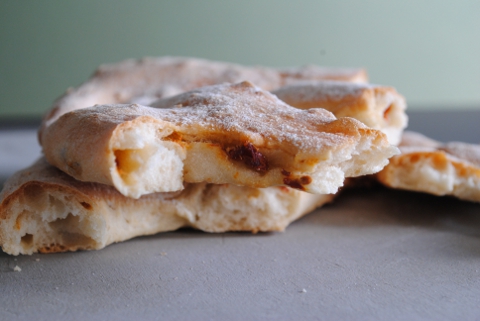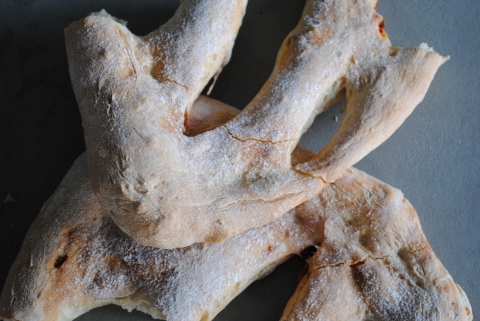Fougasse
Yesterday I was in the mood to bake but I didn’t have enough flour left for a decent-sized loaf. I decided to make a couple of fougasse, a French flatbread that is often, though not necessarily, decorated with incisions that make it resemble a giant pretzel. At least, that’s what my youngest daughter thinks. The name fougasse derives, like the Italian focaccia, from the Latin for ‘hearth’, as these sorts of breads were originally thought to have been baked on flat stones heated in the embers of extinguished fires. It was also the pen name of the British cartoonist Cyril Bird, whose progaganda posters of the Second World War made the phrase ‘careless talk costs lives’ ubiquitous.
You can use a simple white bread dough to make fougasse, and it is common to incorporate solid ingredients such as cheese, olives, herbs, onions or anchovies. On this occasion I used sun-dried tomatoes. It’s down to individual preference as to what, if any, additional ingredients you use, but remember that less is usually more. Anything you add will interfere with the rising of the dough, so it really doesn’t pay to cram it full.
It’s down to individual preference as to what, if any, additional ingredients you use, but remember that less is usually more. Anything you add will interfere with the rising of the dough, so it really doesn’t pay to cram it full.
 Flatbreads don’t generally need proving, so mix and knead the dough as usual and then incorporate any additions – I find the easiest way is to tug the dough into a rough sheet and spread the ingredients more or less evenly across it before folding it into thirds and leaving it to rise for an hour or so.
Flatbreads don’t generally need proving, so mix and knead the dough as usual and then incorporate any additions – I find the easiest way is to tug the dough into a rough sheet and spread the ingredients more or less evenly across it before folding it into thirds and leaving it to rise for an hour or so.
Following bulk fermentation I divide the dough as necessary. To make a single fougasse only requires a lump of dough about the size of a tennis ball. On a floured worksurface, tease and prod the dough into a leaf-shape. Then use the corner of a dough scraper to make a single cut right through the dough, down the middle. Pull the cut edges apart or it will close up during baking. Then, either side of the central cut, make two smaller cuts at 45° and open these out also. Once this is done you cannot easily move the dough, so unless you have a peel and the skill to use it, it’s advisable to prepare the dough on a baking sheet so that you can put the whole lot in the oven when you’re finished.
 Although not difficult to make, fougasse look good and always get an appreciative response when shared. For that reason, they’re a particularly satisfying way to get children involved in breadmaking – a subject I hope to be posting about in the near future.
Although not difficult to make, fougasse look good and always get an appreciative response when shared. For that reason, they’re a particularly satisfying way to get children involved in breadmaking – a subject I hope to be posting about in the near future.
